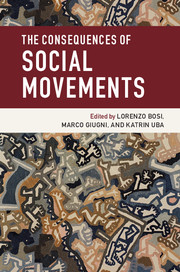Book contents
- Frontmatter
- Contents
- List of figures
- List of tables
- List of contributors
- Introduction
- Part I People
- Part II Policies
- Part III Institutions
- 11 The impact of social movements on political parties
- 12 Watershed events and changes in public order management systems: organizational adaptation as a social movement outcome
- 13 The institutionalization processes of a neo-Nazi movement party: securing social movement outcomes
- 14 Incorporation and democratization: the long-term process of institutionalization of the Northern Ireland Civil Rights Movement
- Conclusion
- Index
- References
14 - Incorporation and democratization: the long-term process of institutionalization of the Northern Ireland Civil Rights Movement
from Part III - Institutions
Published online by Cambridge University Press: 05 January 2016
- Frontmatter
- Contents
- List of figures
- List of tables
- List of contributors
- Introduction
- Part I People
- Part II Policies
- Part III Institutions
- 11 The impact of social movements on political parties
- 12 Watershed events and changes in public order management systems: organizational adaptation as a social movement outcome
- 13 The institutionalization processes of a neo-Nazi movement party: securing social movement outcomes
- 14 Incorporation and democratization: the long-term process of institutionalization of the Northern Ireland Civil Rights Movement
- Conclusion
- Index
- References
Summary
It is quite common nowadays in the social movement literature to recognize that “no protest wave ends up where it began” (Koopmans 2004: 22). If this is true, as we believe it is, we should also recognize that in such transformation what changes are the continuous interactions between different actors in the political system, and in particular the interactions between the movement and the state. This changing power relation between the different actors is, more often than not, a critical catalyst for a change in the distribution of power – whether this has positive effects, or results in a backlash for the social movement and its constituency. What we surely can say is that no protest wave leaves the power relation between the movement's constituency and the state unaffected. Thus, the aim of this chapter is to study how political changes (that either benefit or damage the collective good) emerge from the complex interplay of state and social movement, and to study the shifting balance of power relations between them at different stages of the institutionalization process.
By “social movement institutionalization,” this chapter means the process of inclusion in the terrain of formal politics of some of its ideas (i.e., movement concerns come to be recognized as legitimate within mainstream politics and/or among the general public), personnel (i.e., activists gain positions within political parties, committees, and/or the civil service), or whole movement strands (i.e., sections of the movement establish political parties) (Giugni and Passy 1998; Meyer 2007; Suh 2011). Such a process seems to occur only when two conditions are combined: the willingness of the social movement, in whole or in part, to institutionalize, and the consent of the state for such a path to be pursued (Banaszak 2010; Suh 2011). While both are necessary, they do not need to occur simultaneously. Hence, institutionalization is not a linear process, nor a natural evolution of social movement development, and neither is it structurally determined. Rather it is the result of competing strategic choices: those of a social movement (or parts thereof) to participate in the arena of formal politics, and those of the state to integrate movement activists and their demands into political institutions, under specific, favorable conditions.
- Type
- Chapter
- Information
- The Consequences of Social Movements , pp. 338 - 360Publisher: Cambridge University PressPrint publication year: 2016
References
- 15
- Cited by



